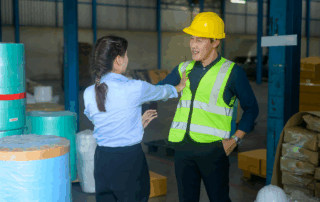A safety committee is crucial for creating and maintaining a safe workplace culture. These committees bring together employees, management and safety professionals to proactively address workplace hazards.
There are several organizational benefits to implementing a safety committee. They can provide a safer work environment,increase employee morale, lower workers’ compensation premiums by improving incident rates and positively affect an organization’s bottom line. To ensure safety committees are effective and inclusive and achieve their intended goals,employers should follow these best practices.
Determine Appropriate Committee Size and Makeup
Ideally, committees should consist of representatives from each department and different shifts. The size will depend on how big the organization is, the nature of the organization’s operations and, if applicable, legal requirements. The committee might only have a few members if the organization is small; if the organization is large, there may be several members from various departments and work shifts. The most important part is ensuring all relevant departments have representation and both employees and management have a voice on the committee.
Think About Term Length
It is important to consider the appropriate term of service for safety committee members. Members should serve on the committee long enough to develop expertise and elicit change but should be rotated out often enough to allow new employees to participate and bring fresh perspectives.
Some organizations switch out members on a rotational basis. For example, some committee members might have a three-year term, meaning that one-third of the general members would rotate each year, while other members have a two-year term, meaning half of the members would change annually.
However, it’s essential to consider the impact of committee selection and term length carefully. Overall, employers want to avoid diminishing the number of experienced and knowledgeable members by allowing a large percentage of the general membership to rotate out of the committee too frequently.
Define Clear Roles
There are different roles and responsibilities within a safety committee to help the committee run smoothly and effectively.These roles will vary depending on the size of the organization. Roles on safety committees can include but are not limited to the following:
- The chairperson develops agendas, leads meetings, assigns tasks, follows up on issues, and serves as a liaison between management and the committee. The chairperson should be knowledgeable, respected and enthusiastic about the safety program.
- The vice chairperson steps in when the chairperson is unavailable, participates in subcommittees and helps coordinate activities to ensure continuity.
- The secretary records and distributes meeting minutes, promotes safety and communicates with employees. The role is typically rotated annually.
- General members represent various organizational departments, including administration and operations, and contribute based on clearly defined roles.
Conduct Regular Meetings
Safety committee meetings should be regularly scheduled. Depending on the size of the committee or the number of action items to discuss, meetings can be held monthly or quarterly. If the committee has employees who work different shifts, it’s important to schedule a meeting time that accommodates all employees.
Alternatively, employers might consider holding a safety meeting for each shift of employees. If there are multiple meetings,the leader of the committee needs to relay the information from one meeting to the next and keep track of what was discussed.
Additionally, organizations should consider convening safety committee meetings on an ad hoc basis in response to major safety incidents or in cases where serious safety concerns are identified or reported.
Secure Leadership’s Commitment
The promotion of a safe workplace starts at the top of an organization, so senior leadership should support the formation of a safety committee within the organization. Leadership needs to facilitate changes to the safety culture; otherwise, the safety committee will likely not work. Employees who witness leadership’s commitment to a better safety culture will be encouraged to promote that culture.
Leaders can be members of the committee or participate by attending the initial meeting and then periodically after that.However, if senior leadership is involved as a member of the safety committee, it should be established that employees can voice concerns about safety hazards without feeling like they will be reprimanded for doing so. Speaking up should be encouraged.
If leadership decides to make periodic visits to safety committee meetings, they must read the minutes from each meeting and address questions or concerns that were not able to be answered by managers or supervisors.
The most significant takeaway regarding leadership in safety committees is that the committee must have the authority to make changes, and the leadership team must support that authority.
Establish a Safety Committee Policy
Safety committees should create a written policy that outlines the elements of the safety program and is regularly referred to as the committee develops. Furthermore, the safety committee should have a mission statement that summarizes the committee’s purpose, values and objectives. These two items will dictate the direction the safety committee will take.
When a safety committee begins to identify its goals and objectives, it should align with the specific needs of the organization. This is to create an overarching focus on creating a safer work environment. Some examples of safety committee goals and objectives include the following:
- Promoting a safe and healthy work environment
- Reducing workplace accidents and injuries
- Reducing or eliminating hazards
- Encouraging employee participation in safety
- Conducting safety audits
- Reviewing incidents to determine injury trends
- Providing insight into safety training
- Creating emergency response plans
- Improving communication and awareness of safety concerns with other employees
Execute Responsibilities Effectively
The primary responsibilities of safety committees should include:
- Developing and reviewing safety policies and procedures
- Evaluating all safety and health programs
- Conducting workplace safety audits
- Reviewing workplace accidents, illnesses, exposures and near misses for potential hazard trends
- Assessing the organization’s OSHA compliance
- Communicating the organization’s safety mission statement
- Providing another avenue for employees to bring up safety concerns
- Ensuring that job-specific training is current
- Making recommendations in response to hazards and accidents
- Connecting the company with external safety resources
- Hosting safety suggestion contests (e.g., best callout and fix of the month)
- Managing safety poster awareness programs
- Inviting guest speakers and conducting seminars
- Providing safety training
- Managing the employee safety suggestion box
- Launching injury prevention campaigns (e.g., back injury prevention; slip, trip and fall prevention; ergonomics)
- Presenting special safety recognition awards
- Creating and distributing newsletters and other promotional materials
- Hosting health and wellness fairs
Giving these duties to a safety committee helps integrate safety into the organization’s culture, procedures and programs. By involving employees in the development and implementation of policies, procedures, programs and training, employees will be able to see first-hand how crucial safety is to an organization.
Evaluate the Committee’s Performance
A safety committee’s progress should be reviewed at least annually to assess its effectiveness in helping the organization achieve its safety goals and objectives. Evaluations should identify both accomplishments and areas for improvement, allowing the committee to refine its efforts as needed to support the organization’s ongoing commitment to creating an accident-free workplace.
Ensure the Committee Responds
Safety committees should address employee reports of safety hazards to maintain a safe and healthy work environment.Employees are often the first to notice potential risks, and by taking their reports seriously, the committee can promptly identify and resolve hazards before they cause accidents or injuries.
This responsiveness not only prevents injuries but also fosters a culture of open communication where employees feel valued and empowered to contribute to workplace safety. Addressing these reports also demonstrates the organization’s commitment to safety, helps ensure compliance with legal standards and reduces the likelihood of costly incidents.
Conclusion
Safety committees’ active promotion of safety initiatives and training not only enhances awareness but also empowers employees to take ownership of their safety. By establishing clear goals, ensuring diverse representation, promoting open communication and addressing specific employee safety concerns, these committees can be effective and drive continuous improvement.
Ultimately, implementing best practices for safety committees fosters a proactive safety culture, ensures timely risk mitigation, and strengthens trust between employees and management, creating a safer and more productive workplace.
For additional risk management resources, contact INSURICA today.
This is not intended to be exhaustive nor should any discussion or opinions be construed as legal advice. Readers should contact legal counsel or an insurance professional for appropriate advice. ©2024 Zywave, Inc. All rights reserved
About the Author
Share This Story
Related Blogs
Trump Administration Reshapes Health Plan Oversight
The Trump administration has issued a series of executive orders aimed at recalibrating federal oversight of employer-sponsored health plans. These directives target unpublished rules and agency enforcement priorities, signaling a shift toward deregulation and increased flexibility for plan sponsors.
Keeping Our Workplace Violence-Free
Although we do our best at to keep the workplace safe, violence inflicted by an outsider or between employees remains a serious safety and health issue. It can occur inside or outside the workplace and can range from threats and verbal abuse to physical assaults and homicide. In fact, according to the United States Department of Labor, workplace violence is the fourth-leading cause of fatal occupational injury in our country.
Understanding Educators Legal Liability (ELL)
Educators face unique professional exposures that go beyond standard general liability. That’s where Educators Legal Liability (ELL) coverage comes in. Understanding Educators Legal Liability is critical for school administrators, as it protects against claims related to employment practices, student rights, professional duties, and more. From wrongful termination to student disciplinary disputes, ELL can provide defense and indemnity for claims that other policies may exclude.








